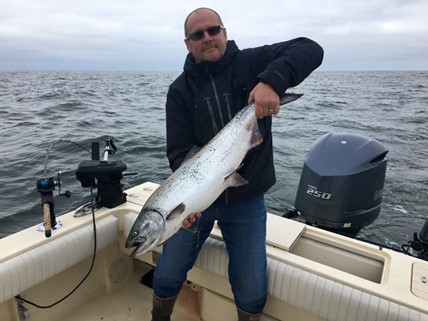The meeting produced encouraging news for bluefin tuna, Pacific anchovy, groundfish and drift gillnetting
Earlier this month, I attended the Pacific Fishery Management Council (PFMC) meeting in Vancouver, Wash. While this was my first council meeting as an ASA Government Affairs team member, it isn’t my first council meeting. Over the past twenty years, I attended many meetings as a staff member with the Washington Department of Fish and Wildlife. The PFMC manages fisheries for salmon, groundfish, coastal pelagic species, such as sardines and anchovies, and migratory species, such as tuna and sharks.
Being able to meet face-to-face with federal and state policymakers who oversee recreational fishing management policies throughout Pacific coast states is essential to our success. was joined by representatives from other like-minded organizations, such as the Sportfishing Association of California and the California CCA. It was great to see everyone in person again after participating virtually throughout the COVID-19 pandemic.
Bluefin Tuna Update
The council meeting offered exciting news for Pacific coast sportfishing. The PFMC announced that the rebuilding goal for Pacific bluefin tuna exceeded expectations. According to stock assessments by the Intra-American Tropical Tuna Commission (IATTC), the population bottomed out in 2010 and has been rebuilding ever since.
Conservation methods that were originally introduced in California have clearly helped grow the population, and we are optimistic that the population will continue to climb over the next several years. Although there is some concern that non-domestic catch totals might be increased soon, the council hopes that any changes in catch totals of the Pacific bluefin tuna are done conservatively to ensure that it does not result in overfishing.
Pacific Anchovy Update
The PFMC’s Coastal Pelagic Working Group also announced the results of the biomass assessment completed by NOAA and the Southwest Fisheries Science Center for Pacific anchovy. Although the assessment reported a higher level of anchovy biomass than expected, California decided to continue managing Pacific anchovy populations at current rates. These catch standards still fall in line with federal regulations for forage fish, ensuring that no further restrictions are currently necessary.
Groundfish and Rockfish Update
The council also debated the catch assessment methods for groundfish and rockfish. Two new California recreational fish measurements were adopted that could lead to a bag limit change for quillback rockfish, copper rockfish and vermillion if needed. The second measure allows for a modification to the use of Rockfish Conservation Areas (RCA) for recreational fisheries. Under this plan, RCAs could be used to close areas shoreward of a depth boundary. Previously, RCAs could only be set seaward of a boundary depth.
Currently, nearshore rockfish is measured through recreational fishing assessments, which are estimates of fish populations based on fishermen’s catch totals. While the council questions the accuracy of these estimates relative to actual stock biomass, ASA hopes that the new California measurement adoptions will help ease this issue. I am also pleased to announce that the PFMC read a letter submitted by Rep. Jared Huffman (D-Calif.) requesting additional funding to be dedicated to improving our understanding of rockfish abundances using fishery-independent assessment methods.
The PFMC’s Science Center also announced that they are reviewing the impacts that descending devices have on rockfish survival rates. California announced that the study could help them to re-evaluate mortality rates, which could lead to an in-season management review, and ultimately more time on the water. ASA is a long-time supporter of using descending devices for species that experience barotrauma while returning to the depths and look forward to the continued adoption of these devices on the West coast.
Drift Gillnets Update
Lastly, the council announced a temporary hard cap for drift gillnetting. Despite the hard cap being introduced, the council is not expected to take a final action on drift gillnetting until November 2022. ASA opposes the use of detrimental commercial fishing gear within fisheries, and we look forward to working with the council and other stakeholders on this policy issue in the future.
For more information on ASA’s West coast efforts, feel free to contact me, Larry Phillips, Pacific Fisheries Policy Director or go to Keep America Fishing.
Share This Article, Choose Your Platform:
Recent Posts



